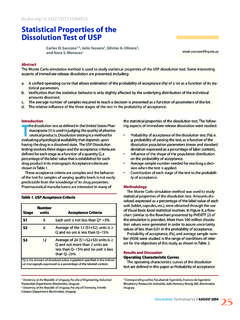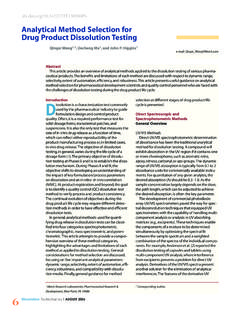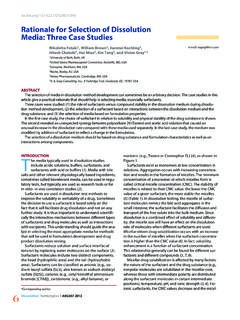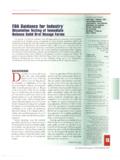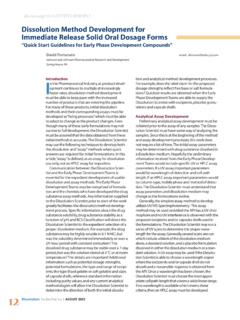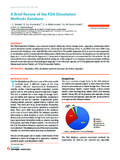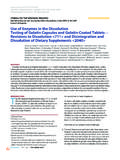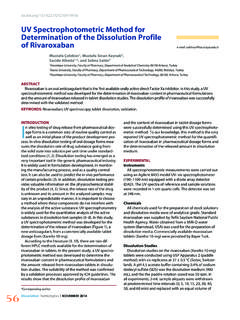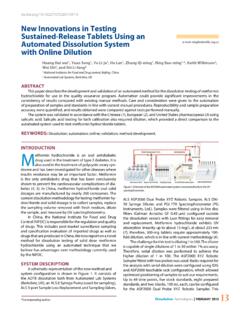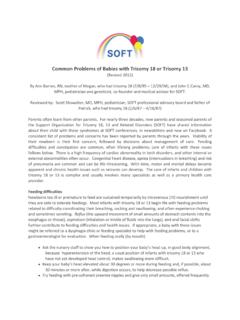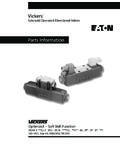Transcription of European versus United States Pharmacopeia Disintegration ...
1 European versus United States Pharmacopeia Disintegration Testing Methods for Enteric-Coated soft Gelatin Capsules J. Al-Gousous and P. Langguth*. Institute of Pharmacy and Biochemistry, Johannes Gutenberg University, Mainz, Germany e-mail: ABSTRACT. The aim of this work was to investigate the differences between the Disintegration testing methods specified by the United States Pharmacopeia (USP) and the European Pharmacopoeia (Ph. Eur.) for enteric-coated soft gelatin capsules. Disintegration of the coated capsules in the pH buffer stage of the test was much faster under the conditions specified by Ph. Eur. than under the conditions specified by the USP. Further investigation showed that the differences are related to the different buffer capacities and the ionic strengths of the media specified by the two pharmacopeias. This shows the importance of harmonizing such tests among the different pharmacopeias and accounting for factors like buffer capacity and ionic strength when designing appropriate media for Disintegration and dissolution tests.
2 KEYWORDS: Enteric-coated soft gelatin capsules; dissolution; Disintegration . INTRODUCTION For Disintegration testing in particular, the picture is further E. nteric coatings have been used for decades to delay complicated by the fact that different pharmacopeias drug release from oral solid dosage forms until specify different test conditions for enteric-coated after gastric emptying either to protect the active products. Table 1 summarizes the differences between ingredient from degradation by gastric acid or to protect the Disintegration testing conditions specified for enteric- the gastric mucosa from irritation caused by the active coated soft gelatin capsules by Ph. Eur. and the USP. In this ingredient. These coatings are based on pH-sensitive work, we studied the differences in the test results of the film-formers that should prevent release under the methods when performed on enteric-coated soft gelatin acidic conditions in the stomach but allow it under the capsules manufactured in-house.
3 The exact causes higher pH conditions in the small intestine. Therefore, for behind these differences were also investigated. Disintegration and dissolution testing, a two-stage testing approach was adopted by the different pharmacopeias for such products: a first stage done in an acidic medium Table 1. Differences Between the Disintegration Testing Methods for where the coat should prevent Disintegration and drug Enteric-Coated soft Gelatin Capsules According to Ph. Eur. and USP. release, and a second stage in a higher pH buffer where Characteristic Ph. Eur. USP. the dosage form should disintegrate (1, 2). Acid Stage Medium M HCl M HCI M NaCl However, that the employed testing conditions accurately w/v pepsin simulate gastrointestinal (GI) conditions is questionable. Acid Stage Duration 2h 1h For example, a study performed by Wagner et al. (3). more than 40 years ago provided an example where Buffer-Forming Species aminosalicylic acid enteric-coated tablets passed the USP ( , phosphate) Total Conc.
4 (M). Disintegration test but failed to release the drug in vivo. In addition, in a study by Wilding et al. (4), enteric-coated pH Buffer- Ionic Strength (M) naproxen tablets took much longer to disintegrate after Stage Medium K+( M). Counterions Na+. gastric emptying in vivo than in the buffer stage of the Na+ ( M). BP 1988 Disintegration test. Another study by Cole et al. Inclusion Inclusion (5) showed that the onset of release from enteric-coated of enzymes Other Differences of enzymes not mandatory HPMC capsules was appreciably earlier during the pH mandatory buffer stage of in vitro dissolution testing than after gastric emptying in vivo. *Corresponding author. 6 Dissolution Technologies | AUGUST 2015. MATERIALS AND METHODS. Materials Uncoated size 4 oval placebo soft gelatin capsules Mean Disintegration time post-acid stage (min). 100. were received as a gift from Catalent Pharma Solutions (Eberbach, Germany). Shellac aqueous solution Ph. 80. Eur.
5 (Aqualacca 25) was received as a gift from Chemacon USP 60. (B hl, Germany). HPMC (Pharmacoat 606) was received n=6. SD. as a gift from HARKE (M lheim an der Ruhr, Germany). All 40. the other materials used were of analytical grade. 20. Coating of soft Gelatin Capsules Batches of soft gelatin capsules were coated to levels of 0. 10 12 14 16 18 20. 12, 15, and 18 mg solid/cm2 with a coating formulation Theoretical coating level (mg solids per cm2). composed of shellac, HPMC, and glycerin ( w/w/w) dissolved in water at a total concentration of Figure 1. Di erences in Disintegration times between Ph. Eur. w/w coating solids. A Glatt GC-300 drum coater and USP methods. (Glatt, Germany) was used. The coating parameters were as follows: 900 g uncoated capsules batch weight; inlet and exhaust air preheated at 30 C for 30 min; coating 120. solution input rate of 5 g/min; air flow rate of 100 100. m3/h; coating inlet air temperature of 35 C; exhaust air Mean Disintegration time (min).
6 80. temperature of 30 C; atomizing air pressure of bar; 60. and a rotational drum speed of 20 rpm. n=6. SD. 40. Disintegration Testing 20. All batches were tested using both the USP and Ph. Eur. 0. conditions. In addition, a series of Disintegration tests USP Acid stage duration Enzymes Ionic strength Bu er Capacity+ Ph. Eur. Ionic strength Test method used (with the four middle columns showing the feature(s) of the USP test that were was performed on the 15-mg/cm2 batch, where in each changed to a value equal to that found in the Ph. Eur. test). test, some parameter of the USP test was changed to what is specified by Ph. Eur. In one test, it was the Figure 2. Investigations leading to the causes underlying the di erent Disintegration times of enteric-coated soft gelatin duration of the acid stage; in the second test, it was capsules. the absence of enzymes; in the third test, it was the ionic strength (adjusted using sodium and potassium DISCUSSION. chloride to maintain the potassium sodium ratio) of the The buffer specified by Ph.
7 Eur. for Disintegration testing buffer; and in the fourth, it was both the total phosphate of enteric-coated products promotes faster Disintegration concentration (reflecting the buffer capacity) and the than that specified by the USP. The differences in the ionic strength of the buffer. results between the two methods were related to the RESULTS different phosphate concentrations (and therefore buffer All the tested capsules withstood the acid stages. As capacities) and ionic strengths of the two media. The for the buffer stages, large differences among the higher buffer capacity of the Ph. Eur. medium (due to its Disintegration times obtained with the two methods were higher phosphate molarity) results in a higher pH in the found as shown in Figure 1. The Disintegration times were immediate vicinity of the shellac molecules within the consistently longer in the USP medium than in the Ph. Eur. coat. The acidic shellac molecules cause the pH within the medium.
8 These differences were large to the extent that coat to be lower than the bulk pH, and in a higher buffer all the three batches passed the Ph. Eur. test but failed capacity medium, this difference will be smaller, which will the USP test. allow a greater degree of shellac ionization. In addition, the higher ionic strength of the Ph. Eur. medium will An investigation of the causes behind these differences shift the mass balance between ionized and un-ionized showed that the duration of the acid stage had only a shellac in the ionization-promoting direction because small effect and the enzymes had almost no effect, but higher ionic strength will reduce the values of the activity ionic strength and buffer capacity had large effects and coefficients of ionized shellac molecules. This will lead to were the major factors in play (Figure 2). further ionization of shellac to compensate the effect of Dissolution Technologies | AUGUST 2015 7. reduced activity coefficients on the activity values and REFERENCES.
9 Maintain chemical equilibrium. These findings are in line 1. European Pharmacopoeia, 8th ed.; European with the findings of other groups (7 9) concerning the Directorate for the Quality of Medicines & Healthcare, effects of changing buffer composition on the dissolution Council of Europe: Strasbourg, France, 2012. characteristics of enteric-coated tablets and pellets. For 2. The United States Pharmacopeia and National other enteric-coated products, the testing conditions Formulary USP 35 NF 30; The United States for tablets are the same as those for capsules in Ph. Eur. Pharmacopeial Convention, Inc.: Rockville, MD, 2012. In the USP, they are the same as those specified for soft 3. Wagner, J. G.; Wilkinson, P. K.; Sedman, A. J.; Stoll, R. gelatin capsules except for the fact that the use of disks is G. Failure of USP tablet Disintegration test to predict omitted for tablets. Therefore, larger differences than the performance in man. J. Pharm. Sci. 1973, 62 (5), 859.
10 Ones observed in this study would not be surprising if the 860. DOI: product studied was an enteric-coated tablet product. 4. Wilding, I. R.; Hardy, J. G.; Sparrow, R. A.; Davis, Questions will arise concerning which test conditions are S. S.; Daly, P. B.; English, J. R. In Vivo Evaluation of more biorelevant, and thus more suitable to be adopted. Enteric-Coated Naproxen Tablets Using Gamma Considering the fact that the buffers specified for this test Scintigraphy. Pharm. Res. 1992, 9 (11), 1436 1441. by both pharmacopeias exhibit a buffer capacity much DOI: :1015858829187. higher than that of intestinal fluid (with this difference 5. Cole, E. T.; Scott, R. A.; Connor, A. L.; Wilding, I. R.;. being much bigger in the case of Ph. Eur.) and that the Ph. Petereit, ; Schminke, C.; Beckert, T.; Cad , D. Eur. buffer also exhibits a much higher ionic strength (10), Enteric coated HPMC capsules designed to achieve the USP buffer might be considered as potentially more intestinal targeting.
